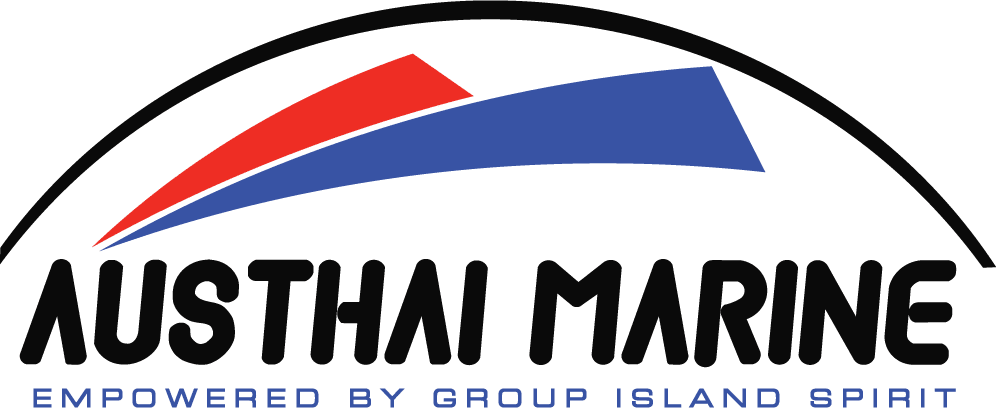Austhai Marine
WHY CHOOSE A CATAMARAN FOR COMMERCIAL SERVICE?
Because it rides so much more smoothly
Why? A cat has twin narrow tunnels that lift on the water and slice through it, whereas a monohull sits in the water and has much more surface area of the boat in contact with the water, and the broader surface of the monohull tends to slap at the water. A cat also has a tunnel, the front of which acts as a funnel, dragging air and spray into the tunnel. The faster the cat goes, the more air and spray is driven into the tunnel.
This air and spray is compressed as the tunnel height decreases towards the stern of the catamaran. This creates a lifting effect, which tends to lift the boat on top of the water, instead of riding through it. It also reduces the lift on a wave and, as the cat rises on a wave and comes back down, this trapped compressed air and spray acts as a shock absorber, making the ride smoother and more comfortable.
The result is that a cat rides on a cushion of air , spray and foam rather than pounding through the waves as is typical with a monohull.
Even with a deep-V monohull, the displacement of water still spans a width equal to the beam of the boat. On the other hand, a cat’s hulls displacement is generally less than two thirds of the beam, hence you have a much narrower hull slicing through the water with a cat.
BECAUSE IT IS SO MUCH MORE STABLE

Why? With monohull designs, the deeper the V, the greater the rolling effect when at rest. This is because the maximum buoyancy is on the center line of the boat with reduced buoyancy on the outer sides. When the V is flattened to give more stability, the boat will roll less but will pound on the waves when in motion, rather than slicing through them.
A cat has its flotation on the extreme outside sections of the hull, which creates maximum buoyancy where it is needed to prevent rolling, whilst retaining the narrow hulls to move through and above the waves.
BECAUSE IT IS MORE FUEL EFFICIENT
Why? The main factors that influence fuel economy are weight and hull design. It is common sense that the heavier the boat, the more power that is required to push it along and the more power, the more fuel used. For example – a 26’ monohull that weighs approximately4.5 tons, powered by twin 230hp V6 MerCruisers, cruising speed would be approximately 22 knots and maximum speed would be approximately 30 knots. Fuel used at cruising speed would be approximately 90 liters per hour total.
Whereas a 26 foot catamaran that weighs 2.2 tons, powered by twin 115hp 4 stroke outboards, cruising speed 26 knots and maximum speed 36 knots, the fuel used at cruising speed is only approximately 45 liters per hour total – which is half as much!
More importantly though is the hull design. The wetted surface is the area of hull(s) touching the water when running. The more wetted surface, the more drag and friction that is created. This means more power is required to move the boat and, once again, more power means more fuel used. With a catamaran, a genuine planing cat, there is as much as 40% less wetted surface than a comparatively sized monohull.
The upshot of this is that the catamaran can be moved using less power and less fuel to achieve the same speeds. This can be demonstrated by the clean spray coming from the chines when the catamaran is at speed.
BECAUSE THEY ARE SAFER

Why? Firstly, the more stable the boat, the safer it is. Secondly and more importantly, a cat hull means twin engines and twin engines gives you double the security. If you lose an engine miles out to sea, a cat hull will still be able to steer straight and get you home at a respectable speed. Some catamarans can even plane with just one engine.
Lose an engine on a twin engine monohull and yes, you’ll get home, but you’ll be fighting with the steering all the way and the boat simply won’t steer straight. That would be a long boat ride home!
Another major safety feature with Austhai catamarans has to do with the hull construction method. A series of fiberglass bulkheads forming several water tight compartments are fitted into each hull. This gives great structural strength. Then, a series of solid glass cross-bearers are placed across the hull to support the floor and deck. Fuel and water tanks are fitted into place between the bulkheads and are foamed into position to prevent movement.
This construction method means that if the worst does happen and you find yourself floating in the water with your boat upside down, the hull will always remain at float instead of sinking to the ocean floor. This is called positive buoyancy. This is one of the many reasons that catamarans are the preferred choice for rescue and commercial vessels.

